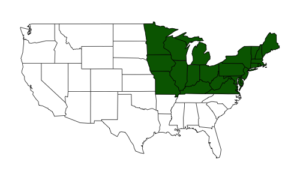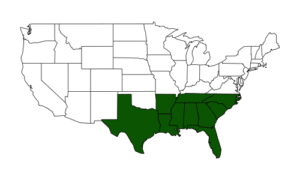Continental Summary
While the West saw early and late forecast period light to moderate movements along the Pacific Coast and in the Desert Southwest including Broad-tailed Hummingbird, Orange-crowned Warbler, Black-headed Grosbeak, and Bullock’s Oriole, scattered light to moderate movements peaking on Tuesday and Wednesday nights including Greater White-fronted Goose, Blue-winged Teal, Barn Swallow, Brown Thrasher, Lapland Longspur, Vesper Sparrow, and Chipping Sparrow increased in the East.
Curious what birds will move next? Check out our forecast.
Need a review of our definitions for regions, species on the move, and migration amounts? Please visit this link.
Quick Links to Regions
Upper Midwest and Northeast |
Gulf Coast and Southeast |
Great Plains |
West |
Upper Midwest and Northeast
The Central Mississippi and Ohio River valleys were the active portions of the region last weekend, though active is an overstatement as migration was generally light to moderate. A disturbance moving into and across the region on Tuesday and Wednesday nights saw southerly winds and warming temperatures with its advance, facilitating slightly more widespread movements of the same magnitude from the Ohio River valley and northern Appalachians east to the Atlantic. This disturbance grew into a substantial cold front that ended the period by shutting down most movements with its passage.
Top Movers
Increasing
| Species | Increase from Last Week | % of Checklists Reporting |
|---|---|---|
| Eastern Phoebe | 85% | 7.8 |
| Horned Grebe | 76% | 8.4 |
| Chipping Sparrow | 399% | 2.4 |
| Great Blue Heron | 49% | 13.6 |
| Pied-billed Grebe | 55% | 5.9 |
| Bonaparte's Gull | 89% | 2.6 |
| Blue-winged Teal | 55% | 3.6 |
| Tree Swallow | 44% | 7.0 |
| Common Loon | 51% | 4.5 |
| Osprey | 47% | 3.8 |
| Wilson's Snipe | 69% | 2.1 |
| Brown Thrasher | 167% | 1.3 |
| Double-crested Cormorant | 36% | 5.4 |
| Wood Duck | 24% | 13.7 |
| Great Egret | 129% | 1.0 |
| Song Sparrow | 16% | 36.3 |
| Belted Kingfisher | 42% | 4.1 |
| Hooded Merganser | 17% | 15.7 |
| Northern Rough-winged Swallow | 132% | 0.4 |
| Fox Sparrow | 24% | 4.6 |
| American Robin | 13% | 49.6 |
| Eastern Towhee | 36% | 4.2 |
| Northern Flicker | 26% | 8.8 |
| Bufflehead | 19% | 16.4 |
| Turkey Vulture | 16% | 22.6 |
Decreasing
| Species | Decrease from Last Week | % of Checklists Reporting |
|---|---|---|
| American Tree Sparrow | -18% | 8.8 |
| Canvasback | -20% | 4.3 |
| Common Goldeneye | -10% | 8.6 |
| Greater Scaup | -12% | 4.3 |
| Greater White-fronted Goose | -45% | 0.9 |
| Horned Lark | -26% | 3.5 |
| Lapland Longspur | -42% | 0.2 |
| Northern Pintail | -30% | 4.3 |
| Red-necked Grebe | -18% | 0.8 |
| Redhead | -14% | 7.3 |
| Sandhill Crane | -35% | 4.4 |
| Short-eared Owl | -37% | 0.2 |
| Snow Bunting | -28% | 0.3 |
| Trumpeter Swan | -33% | 1.1 |
| Tundra Swan | -28% | 3.1 |

Barn Swallow © Benjamin Van Doren
Gulf Coast and Southeast
Local light to moderate movements bookended the weekend to kick off the forecast period, although most movements were at best and primarily close to the immediate Gulf and Florida coasts as precipitation passed through the region. Monday though Wednesday nights saw these movements reach their greatest extents, particularly in Texas and Florida. But by the end of the forecast period, the southern limits of a passing cold front shut down most movements away from central and southern Florida, where moderate movements highlighted incoming migrants from Cuba.
Top Movers
Increasing
| Species | Increase from Last Week | % of Checklists Reporting |
|---|---|---|
| Barn Swallow | 69% | 11.1 |
| Black-and-white Warbler | 24% | 8.6 |
| Black-chinned Hummingbird | 43% | 2.1 |
| Black-throated Green Warbler | 62% | 0.8 |
| Broad-winged Hawk | 44% | 1.2 |
| Bronzed Cowbird | 70% | 1.0 |
| Brown Thrasher | 14% | 14.2 |
| Brown-headed Cowbird | 10% | 15.0 |
| Chipping Sparrow | 11% | 16.8 |
| Cliff Swallow | 68% | 1.5 |
| Great Crested Flycatcher | 46% | 4.1 |
| Louisiana Waterthrush | 60% | 2.6 |
| Northern Rough-winged Swallow | 58% | 6.4 |
| Prairie Warbler | 31% | 3.5 |
| Purple Martin | 16% | 9.4 |
| Ruby-throated Hummingbird | 49% | 4.2 |
| Scissor-tailed Flycatcher | 47% | 2.8 |
| Swainson's Hawk | 90% | 1.1 |
| White-eyed Vireo | 18% | 13.2 |
| Yellow-throated Vireo | 54% | 2.5 |
| Yellow-throated Warbler | 18% | 4.9 |
Decreasing
| Species | Decrease from Last Week | % of Checklists Reporting |
|---|---|---|
| Canvasback | -51% | 0.4 |
| American Pipit | -49% | 0.5 |
| Hooded Merganser | -38% | 1.6 |
| Redhead | -37% | 2.4 |
| American Wigeon | -27% | 2.5 |
| Ring-necked Duck | -54% | 2.7 |
| Sandhill Crane | -44% | 3.0 |
| Green-winged Teal | -37% | 3.4 |
| Ruddy Duck | -34% | 3.4 |
| Lesser Scaup | -36% | 4.5 |
| Gadwall | -30% | 5.6 |
| Dark-eyed Junco | -26% | 6.5 |
| Ring-billed Gull | -26% | 11.1 |
| Eastern Phoebe | -20% | 16.2 |
| Yellow-rumped Warbler | -17% | 27.3 |
Great Plains
The central and southern Plains experienced scattered light to moderate movements over the weekend. With the exception of continued migration in Oklahoma on Monday night, these movements all but shutdown as low pressure moved in the region. The arrival and continued presence of unsettled and generally marginal or unfavorable conditions kept most migrants grounded for the remainder of the period.
Top Movers
Increasing
| Species | Increase from Last Week | % of Checklists Reporting |
|---|---|---|
| Blue-winged Teal | 182% | 24.6 |
| Turkey Vulture | 157% | 16.6 |
| Eastern Phoebe | 75% | 19.9 |
| Northern Shoveler | 50% | 25.5 |
| Bufflehead | 59% | 19.5 |
| Horned Grebe | 136% | 5.1 |
| Vesper Sparrow | 264% | 3.8 |
| Ruddy Duck | 57% | 13.6 |
| Great Blue Heron | 49% | 18.5 |
| Green-winged Teal | 39% | 21.2 |
| Gadwall | 38% | 25.1 |
| Common Grackle | 37% | 25.0 |
| Wood Duck | 50% | 10.0 |
| Pied-billed Grebe | 52% | 9.2 |
| Ring-necked Duck | 43% | 19.7 |
| Western Meadowlark | 43% | 18.3 |
| American Coot | 40% | 15.5 |
| Savannah Sparrow | 68% | 5.7 |
| American Pipit | 103% | 3.2 |
| Red-breasted Merganser | 97% | 4.6 |
| Greater Yellowlegs | 66% | 4.9 |
| Chipping Sparrow | 227% | 1.8 |
| American Wigeon | 34% | 16.6 |
Decreasing
| Species | Decrease from Last Week | % of Checklists Reporting |
|---|---|---|
| American Woodcock | -81% | 0.4 |
| American Tree Sparrow | -24% | 7.7 |
West
Widely scattered and primarily light movements kicked off the weekend in parts of California and the Desert Southwest, continuing in similar fashion into the middle of the work week. Other areas of the West experienced scattered but at times significant precipitation, keeping birds grounded where it fell. However, the departure of these disturbances brought more extensive light to moderate movements to end the period on Wednesday and Thursday nights, particularly from the Pacific Northwest south and east through the Desert Southwest.
Top Movers
Increasing
| Species | Increase from Last Week | % of Checklists Reporting |
|---|---|---|
| Barn Swallow | 30% | 4.4 |
| Bell's Vireo | 58% | 3.1 |
| Black-chinned Hummingbird | 51% | 1.9 |
| Black-headed Grosbeak | 166% | 0.3 |
| Blue-gray Gnatcatcher | 16% | 2.3 |
| Broad-tailed Hummingbird | 230% | 0.6 |
| Bullock's Oriole | 59% | 2.5 |
| Greater Yellowlegs | 19% | 5.4 |
| Hooded Oriole | 42% | 3.9 |
| Lucy's Warbler | 36% | 4.0 |
| Orange-crowned Warbler | 20% | 9.9 |
| Osprey | 25% | 3.8 |
| Tree Swallow | 16% | 12.7 |
| Turkey Vulture | 11% | 17.6 |
| Violet-green Swallow | 41% | 6.9 |
| White-winged Dove | 22% | 4.2 |
| Wilson's Snipe | 28% | 2.2 |
| Wilson's Warbler | 29% | 2.7 |
| Yellow Warbler | 45% | 1.4 |
| Yellow-headed Blackbird | 44% | 2.0 |
Decreasing
| Species | Decrease from Last Week | % of Checklists Reporting |
|---|---|---|
| American Tree Sparrow | -52% | 0.2 |
| Tundra Swan | -40% | 0.7 |
| American Dipper | -31% | 0.5 |
| Mew Gull | -29% | 1.5 |
| Glaucous-winged Gull | -29% | 2.6 |
| Herring Gull | -25% | 1.4 |
| Common Goldeneye | -19% | 6.3 |
| Varied Thrush | -17% | 5.0 |
–––––––––––––––––––––––––––––––––––
Farnsworth and Van Doren







